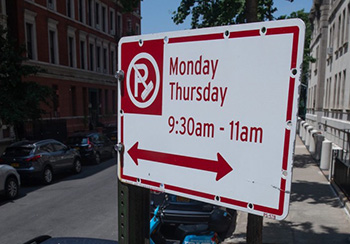The Latest Products and Info
|

New York City Moves to Automate Alternate Side Parking Enforcement with Sweeper CamerasIn a push to make New York City's streets cleaner and safer, the City Council has voted overwhelmingly to support a state bill that would allow the installation of cameras on Department of Sanitation (DSNY) street sweepers to automatically ticket vehicles that violate alternate-side parking rules.(NYC) June 2025 – by Ranger Kidwell-Ross The proposed legislation – known as S1891 in the Senate and A4523 in the Assembly – would authorize cameras to photograph and issue summonses to cars parked along the curb during scheduled street cleaning hours, streamlining enforcement and targeting repeat offenders. Historical Context and PurposeAlternate-side parking (ASP) was introduced in New York City in 1950 as a response to a growing garbage crisis. The policy, initially proposed by sanitation officials and later adopted citywide, required drivers to move their cars to one side of the street on designated days, allowing street sweepers to clear debris and maintain public cleanliness. Over the decades, ASP has been both praised for its role in keeping streets clean and criticized for its inconvenience to drivers, who must navigate a complex schedule of parking restrictions that vary by neighborhood and time of year. The rule is enforced year-round, with exceptions made for holidays and certain emergencies. Despite its longevity, ASP remains a contentious issue, as parked cars often block street sweepers from doing their jobs, leading to litter accumulation, pest infestations, and public health concerns. How the New System Would WorkUnder the proposed legislation, cameras mounted on DSNY street sweepers would automatically photograph vehicles parked illegally during cleaning hours. These images would be used to issue tickets, similar to the MTA's Automated Camera Enforcement (ACE) system, which uses bus-mounted cameras to ticket cars in bus lanes. The program would begin with a 60-day warning period, during which violators would receive warnings instead of fines. After this period, automated tickets would be capped at $50, with an additional $25 late fee for unpaid violations.
Public Health and Urban CleanlinessClean streets are vital for public health. Trash accumulation attracts rats and other pests, which can spread disease and trigger asthma and other respiratory illnesses, especially in densely populated neighborhoods like East Harlem. Street sweepers each remove nearly a ton of debris per shift, but their effectiveness is severely limited when cars block their path. By enforcing ASP more consistently, the city hopes to reduce pest populations and create healthier, more welcoming public spaces. Public Reaction and DebateSupport for automated enforcement is strong among many New Yorkers. Recent polls show that a clear majority of city voters support expanding camera-based enforcement to address traffic violations, citing its fairness and effectiveness compared to traditional policing. Advocates argue that automated systems reduce human bias and free up police and traffic agents for other duties. However, the proposal is not without critics. Some drivers see the initiative as a "money grab" by the city, arguing that parking regulations are already burdensome and expensive. Others express concerns about increased surveillance and the potential for overreach. "It's more Big Brother in the city," said Anna from Staten Island. Despite these concerns, the City Council passed the Home Rule message by a vote of 41 to 8, signaling strong support for the measure. Looking AheadThe bill is currently pending in committee in both the Senate and Assembly, and its fate remains uncertain. If passed, it would represent a significant step forward in the city's ongoing efforts to modernize street cleaning and parking enforcement. The use of technology – such as GPS-based apps to track street sweeper routes – could further streamline the process and help drivers avoid violations.
Ultimately, the goal is not punishment but progress: cleaner streets, fewer rats, and a better quality of life for all New Yorkers. As state Senator Robert Jackson (D-Manhattan) put it, "Just as bus cameras protect transit riders, broom cameras will safeguard public health and urban dignity. This isn't about punishment – it's about progress."
Editor's Note: WorldSweeper has previously promoted guidelines for developing an enhanced street sweeping program. We have suggested putting cameras onto the sweepers themselves. To see that and other aspects suggested for such a program, click here.
|
© 2005 - 2025 World Sweeper All rights reserved. |
Industry Updates Contents
|